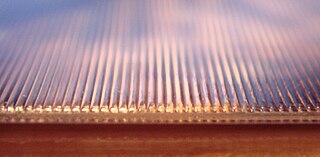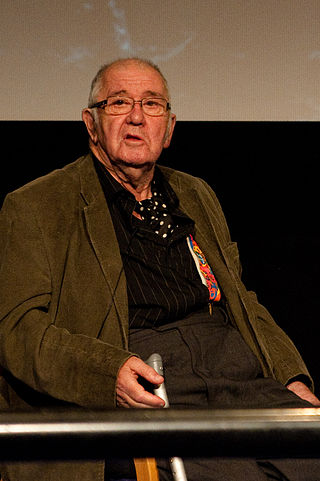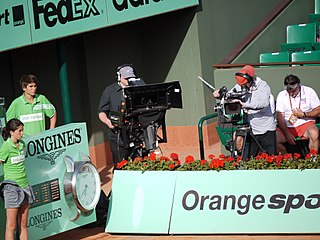
Stereoscopy is a technique for creating or enhancing the illusion of depth in an image by means of stereopsis for binocular vision. The word stereoscopy derives from Greek στερεός (stereos) 'firm, solid', and σκοπέω (skopeō) 'to look, to see'. Any stereoscopic image is called a stereogram. Originally, stereogram referred to a pair of stereo images which could be viewed using a stereoscope.
3D films are motion pictures made to give an illusion of three-dimensional solidity, usually with the help of special glasses worn by viewers. They have existed in some form since 1915, but had been largely relegated to a niche in the motion picture industry because of the costly hardware and processes required to produce and display a 3D film, and the lack of a standardized format for all segments of the entertainment business. Nonetheless, 3D films were prominently featured in the 1950s in American cinema, and later experienced a worldwide resurgence in the 1980s and 1990s driven by IMAX high-end theaters and Disney-themed venues. 3D films became increasingly successful throughout the 2000s, peaking with the success of 3D presentations of Avatar in December 2009, after which 3D films again decreased in popularity. Certain directors have also taken more experimental approaches to 3D filmmaking, most notably celebrated auteur Jean-Luc Godard in his film Goodbye to Language.

A stereoscope is a device for viewing a stereoscopic pair of separate images, depicting left-eye and right-eye views of the same scene, as a single three-dimensional image.
Bertram Wagstaff Mills was a British circus owner originally from Paddington, London, who ran the Bertram Mills Circus. His circus became famous in the UK for its Christmas shows at Olympia in West London televised in 1938, 1946 and 1947. His troupe was the last to perform with live animals on the Drury Lane Theatre stage.

Lenticular printing is a technology in which lenticular lenses are used to produce printed images with an illusion of depth, or the ability to change or move as they are viewed from different angles.

A 3D display is a display device capable of conveying depth to the viewer. Many 3D displays are stereoscopic displays, which produce a basic 3D effect by means of stereopsis, but can cause eye strain and visual fatigue. Newer 3D displays such as holographic and light field displays produce a more realistic 3D effect by combining stereopsis and accurate focal length for the displayed content. Newer 3D displays in this manner cause less visual fatigue than classical stereoscopic displays.

A stereo camera is a type of camera with two or more lenses with a separate image sensor or film frame for each lens. This allows the camera to simulate human binocular vision, and therefore gives it the ability to capture three-dimensional images, a process known as stereo photography. Stereo cameras may be used for making stereoviews and 3D pictures for movies, or for range imaging. The distance between the lenses in a typical stereo camera is about the distance between one's eyes and is about 6.35 cm, though a longer base line produces more extreme 3-dimensionality.

Anaglyph 3D is the stereoscopic 3D effect achieved by means of encoding each eye's image using filters of different colors, typically red and cyan. Anaglyph 3D images contain two differently filtered colored images, one for each eye. When viewed through the "color-coded" "anaglyph glasses", each of the two images reaches the eye it's intended for, revealing an integrated stereoscopic image. The visual cortex of the brain fuses this into the perception of a three-dimensional scene or composition.
Judy Valerie Cornwell is an English actress and writer best known for her role as Daisy in the successful British sitcom Keeping Up Appearances (1990–1995). She also played Anya Claus in Santa Claus: The Movie (1985). In her later years she became known for playing Miss Marple in many stage productions, including A Murder is Announced between 2014 and 2016.
Underwood & Underwood was a producer and distributor of stereoscopic and other photographic images, and later was a pioneer in the field of news bureau photography.
The Keystone View Company was a major distributor of stereographic images, and was located in Meadville, Pennsylvania. From 1892 through 1963 Keystone produced and distributed both educational and comic/sentimental stereoviews, and stereoscopes. By 1905 it was the world's largest stereographic company. In 1963 Department A and the Education Departments were closed down, but Keystone continued to manufacture eye-training stereographic products as a subsidiary of Mast Development Company. In 1972 Mast closed the Meadville manufacturing site.

Stanley A. Long was an English exploitation cinema and sexploitation filmmaker. He was also a driving force behind the VistaScreen stereoscopic (3D) photographic company. He was a writer, cinematographer, editor, and eventually, producer/director of low-budget exploitation movies.

Leonard Lipton was an American author, filmmaker, lyricist and inventor. At age 19, Lipton wrote the poem that became the basis for the lyrics to the song "Puff, the Magic Dragon". He wrote books on independent filmmaking and become a pioneer in the field of projected three-dimensional imagery. Leonard Lipton developed 3D cinema technology that is used in RealD 3D cinemas. His technology is used to show 3D films on more than 30,000 theater screens worldwide.

Tru-Vue, a subsidiary of Rock Island Bridge and Iron Works, was a manufacturer of stereoscopic filmstrips and corresponding stereoscope viewers, based in Rock Island, Illinois, from 1932–1951 and in Beaverton, Oregon, from 1951 until the late 1960s. The film strips, or film cards, were fed through a slide viewer similar to a View-Master, which was art deco or streamlined in style. The viewers were made of bakelite and available in multiple colors. When held up to light the images appeared in 3D. The films were based on attractive scenery, children's stories, travel, night life, and current events. The company was purchased in 1951 by Sawyer's—the manufacturer of the View-Master—because Tru-Vue had an exclusive contract to make children's filmstrips based on Disney characters. Tru-Vue moved at that time from Rock Island, Illinois, to Beaverton, Oregon, near where Sawyer's had built a new plant, and for a few years was a subsidiary company of Sawyer's. Eventually, it became only a brand name. Both View-Master and Tru-Vue products were manufactured into the 1960s by Sawyer's.
Nvidia 3D Vision is a discontinued stereoscopic gaming kit from Nvidia which consists of LC shutter glasses and driver software which enables stereoscopic vision for any Direct3D game, with various degrees of compatibility. There have been many examples of shutter glasses. Electrically controlled mechanical shutter glasses date back to the middle of the 20th century. LCD shutter glasses appeared in the 1980s, one example of which is Sega's SegaScope. This was available for Sega's game console, the Master System. The NVIDIA 3D Vision gaming kit introduced in 2008 made this technology available for mainstream consumers and PC gamers.

Brenda Irene Isabelle Frances Theresa Dean Paul, generally known by her stage name Brenda Dean Paul, was a British silent film actress, socialite, and "Bright Young Thing" in the 1920s. Her use of illegal drugs landed her in court and in the tabloid press of the day. She served time in Holloway Prison and had many stints in hospitals in efforts to shake her addiction.

Stereo photography techniques are methods to produce stereoscopic images, videos and films. This is done with a variety of equipment including special built stereo cameras, single cameras with or without special attachments, and paired cameras. This involves traditional film cameras as well as, tape and modern digital cameras. A number of specialized techniques are employed to produce different kinds of stereo images.

A stereoscopic video game is a video game which uses stereoscopic technologies to create depth perception for the player by any form of stereo display. Such games should not be confused with video games that use 3D game graphics on a mono screen, which give the illusion of depth only by monocular cues but lack binocular depth information.

Barrier-grid animation or picket-fence animation is an animation effect created by moving a striped transparent overlay across an interlaced image. The barrier-grid technique originated in the late 1890s, overlapping with the development of parallax stereography (Relièphographie) for 3D autostereograms. The technique has also been used for color-changing pictures, but to a much lesser extent.
Raumbild-Verlag ("Raumbild") was a German publishing outfit which focused exclusively on stereoscopic imagery, usually accompanied by expository text. Founded in Dießen in the 1930s by Otto Wilhelm Schönstein (1891–1958), Raumbild produced 6x13cm photographic stereo pairs designed to be used with the proprietary fold-out "Photoplastikon" viewer produced for the company, some of which featured Zeiss Jena lenses. Quickly aligning itself with the propaganda arm of the NSDAP, Raumbild moved around several times before settling in Munich in 1939. After the defeat of Germany in the Second World War, Raumbild changed directions in terms of content, while still focusing on subjects relevant to German identity. In 1996, the German Historical Museum obtained the remaining archives of Raumbild, which are now available to researchers.












